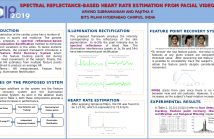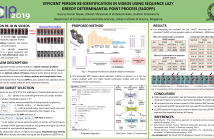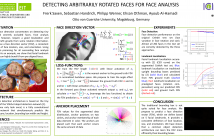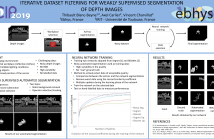
The International Conference on Image Processing (ICIP), sponsored by the IEEE Signal Processing Society, is the premier forum for the presentation of technological advances and research results in the fields of theoretical, experimental, and applied image and video processing. ICIP has been held annually since 1994, brings together leading engineers and scientists in image and video processing from around the world. Visit website.

- Read more about SPECTRAL REFLECTANCE BASED HEART RATE MEASUREMENT FROM FACIAL VIDEO
- Log in to post comments
Remote detection of the cardiac pulse has a number of applications in sports and medicine, and can be used to determine an individual’s physiological state. Previous approaches to estimate Heart Rate (HR) from video require the subject to remain stationary and employ background information to eliminate illumination interferences. The present research proposes a spectral reflectance-based novel illumination rectification method to eliminate illumination variations in the video.
- Categories:
 53 Views
53 Views
- Read more about ManGAN: Assisting Colorization of Manga Characters Concept Art using Conditional GAN
- Log in to post comments
Colorization is a challenging task that has recently been tackled by deep learning. Line art colorization is particularly difficult because there is no grayscale value to indicate the color intensities as there is in black-and-white photograph images. When designing a character, concept artists often need to try different color schemes, however, colorization is a time-consuming task. In this article, we propose a semi-automatic framework for colorizing manga concept arts by letting concept artists try different color schemes and obtain colorized results in fashion time.
- Categories:
 130 Views
130 Views
- Read more about Efficient Person Re-Identification in Videos Using Sequence Lazy Greedy Determinantal Point Process (SLGDPP)
- Log in to post comments
Given a sequence of observations for each person in each camera, identifying or re-identifying the same person across different cameras is one of the objectives of video surveillance systems. In the case of video based person re-id, the challenge is to handle the high correlation between temporally adjacent frames. The presence of non-informative frames results in high redundancy which needs to be removed for an efficient re-id.
- Categories:
 105 Views
105 Views- Read more about Fast 6dof Pose Estimation with Synthetic Textureless Cad Model for Mobile Applications
- Log in to post comments
Performance of 6DoF pose estimation techniques from RGB/RGB-D images has improved significantly with sophisticated deep learning frameworks. These frameworks require large-scale training data based on real/synthetic RGB/RGB-D information. Difficulty of obtaining adequate training data has limited the scope of these frameworks for ubiquitous application areas. Also, fast pose estimation at inference time often requires high-end GPU(s) that restricts the scope for its application in mobile hardware.
- Categories:
 217 Views
217 Views
Current face detection concentrates on detecting tiny faces and severely occluded faces. Face analysis methods, however, require a good localization and would benefit greatly from some rotation information. We propose to predict a face direction vector (FDV), which provides the face size and orientation and can be learned by a common object detection architecture better than the traditional bounding box. It provides a more consistent definition of face location and size. Using the FDV is promising for all succeeding face analysis methods.
- Categories:
 27 Views
27 Views
- Read more about Two-Dimensional Tomography from Noisy Projection Tilt Series Taken at Unknown View Angles with Non-Uniform Distribution
- Log in to post comments
We consider a problem that recovers a 2-D object and the underlying view angle distribution from its noisy projection tilt series taken at unknown view angles. Traditional approaches rely on the estimation of the view angles of the projections, which do not scale well with the sample size and are sensitive to noise. We introduce a new approach using the moment features to simultaneously recover the underlying object and the distribution of view angles.
- Categories:
 22 Views
22 Views
- Read more about ITERATIVE DATASET FILTERING FOR WEAKLY SUPERVISED SEGMENTATION OF DEPTH IMAGES
- Log in to post comments
In this paper, we propose an approach for segmentation of challenging depth images. We first use a semi-automatic segmentation algorithm that only takes a user-defined rectangular area as an input. The quality of the segmentation is very heterogeneous at this stage, and unsufficient to efficiently train a neural network. We thus introduce a learning process that takes this imperfect nature of data into account, by iteratively filtering the dataset to only keep the best segmented images. We show this method improves the neural network’s performance by a significant amount.
- Categories:
 49 Views
49 Views
- Read more about RATE-DISTORTION OPTIMIZED TREE-STRUCTURED POINT-LATTICE VECTOR QUANTIZATION FOR COMPRESSION OF 3D POINT CLOUDS GEOMETRY
- Log in to post comments
This paper deals with the current trends of new compression methods for 3D point cloud contents required to ensure efficient transmission and storage.
The representation of 3D point clouds geometry remains a challenging problem, since this signal is unstructured.
In this paper, we introduce a new hierarchical geometry representation based on adaptive Tree-Structured Point-Lattice Vector Quantization (TSPLVQ).
This representation enables hierarchically structured 3D content that improves the compression performance for static point clouds.
- Categories:
 26 Views
26 Views
- Read more about AUTOMATIC GENERATION OF PHOTOREALISTIC TRAINING DATA FOR DETECTION OF INDUSTRIAL COMPONENTS
- Log in to post comments
With the prosperous development of deep learning, people pay more attention to the needs of different training data. In
this paper, we propose a method to automatically generate realistic training data for industrial components detection. Our
- Categories:
 22 Views
22 Views
- Read more about LIP IMAGE SEGMENTATION IN MOBILE DEVICES BASED ON ALTERNATIVE KNOWLEDGE DISTILLATION
- Log in to post comments
Lip image segmentation, as the first step in many lip-related tasks (e.g. automatic lipreading), is of vital significance for the subsequent procedures. Nowadays, with the increasing computational power of the mobile devices, mobile applications become more and more popular. In this paper, a new approach is proposed, which is able to segment the lip region in natural scenes and is of acceptable computational complexity to be implemented in mobile devices. Two networks including a complex teacher network and a compact student network with the same structure are employed.
- Categories:
 19 Views
19 Views